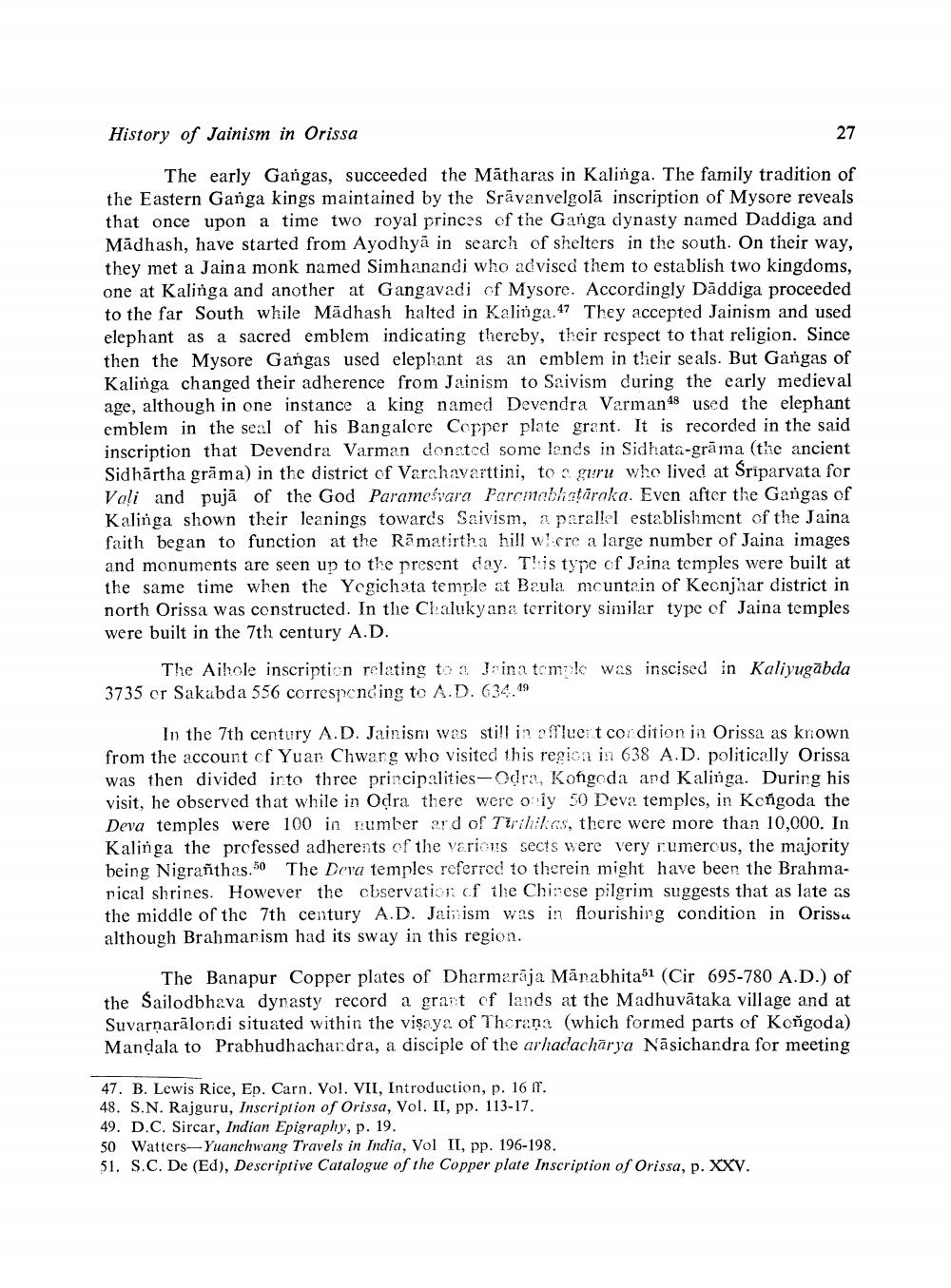________________
History of Jainism in Orissa
27
The early Gangas, succeeded the Matharas in Kalinga. The family tradition of the Eastern Ganga kings maintained by the Srāvan velgolā inscription of Mysore reveals that once upon a time two royal princes of the Ganga dynasty named Daddiga and Madhash, have started from Ayodhyā in search of shelters in the south. On their way, they met a Jaina monk named Simhanandi who advised them to establish two kingdoms, one at Kalinga and another at Gangavadi of Mysore. Accordingly Daddiga proceeded to the far South while Mädhash halted in Kalinga.47 They accepted Jainism and used elephant as a sacred emblem indicating thereby, their respect to that religion. Since then the Mysore Gangas used elephant as an emblem in their seals. But Gangas of Kalinga changed their adherence from Jainism to Saivism during the early medieval age, although in one instance a king named Devendra Varman 48 used the elephant emblem in the seal of his Bangalore Copper plate grant. It is recorded in the said inscription that Devendra Varman donated some lends in Sidhata-grāma (the ancient Sidhartha grāma) in the district of Varahavarttini, to s guru whe lived at Sriparvata for Vali and pujā of the God Paramesvara Parcmabhatāraka. Even after the Gangas of Kalinga shown their leanings towards Saivism, a parallel establishment of the Jaina faith began to function at the Rāmatirtha hill were a large number of Jaina images and monuments are seen up to the present day. This type of Jaina temples were built at the same time when the Yegichata temple at Baula mcuntain of Kecnjhar district in north Orissa was constructed. In the Chalukyana territory similar type of Jaina temples were built in the 7th century A.D.
The Aihole inscription relating to a Jaina temolc was inscised in Kaliyugābda 3735 cr Sakabda 556 corresponding te A.D. 634.19
In the 7th century A.D. Jainism was still ia affluent cor dition in Orissa as known from the account cf Yuan Chwarg who visited this regica in 638 A.D. politically Orissa was then divided into three principalities-Odra, Kongoda and Kalinga. During his visit, he observed that while in Odra there were oly 50 Deva temples, in Kongoda the Deva temples were 100 in number ard of Tirilikos, there were more than 10,000. In Kalinga the professed adherents of the various sects were very numerous, the majority being Nigrañthas.50 The Deva temples referred to therein might have been the Brahmarical shrines. However the cbservation of the Chinese pilgrim suggests that as late as the middle of the 7th century A.D. Jainism was in flourishing condition in Orissa although Brahmanism had its sway in this region.
The Banapur Copper plates of Dharmarāja Mānabhita51 (Cir 695-780 A.D.) of the Sailodbhava dynasty record a grant of lands at the Madhuvātaka village and at Suvarnarālondi situated within the vişaya of Thorana (which formed parts of Koñgoda) Mandala to Prabhudhachardra, a disciple of the arhadachārya Nāsichandra for meeting
47. B. Lewis Rice, Ep. Carn. Vol. VII, Introduction, p. 16 ff. 48. S.N. Rajguru, Inscription of Orissa, Vol. II, pp. 113-17. 49. D.C. Sircar, Indian Epigraphy, p. 19. 50 Watters-Yuanchwang Travels in India, Vol II, pp. 196-198. 51. S.C. De (Ed), Descriptive Catalogue of the Copper plate Inscription of Orissa, p. XXV.




